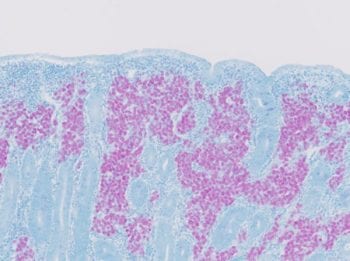22 Jan 2019
Axiom Veterinary Laboratories’ latest update focuses on gastrointestinal and nutritional diseases, including <em>Salmonella</em>, Johne’s disease and heavy metal poisoning.

Image © egonzitter / Adobe Stock
Presented are selected cases from the ruminant diagnostic caseload of Axiom Veterinary Laboratories. The focus for this update is gastrointestinal and nutritional diseases diagnosed in ruminants in autumn and winter 2018.
Several cases of parasitic gastroenteritis were seen in lambs in the autumn, with some very high strongyle egg counts recorded (10,000+ epg). Cases of Nematodirus infection also were seen. The dry early summer followed by rain in August may have led to more cases being reported in late summer and early autumn this year and high counts continued to be seen into December.
Haemonchosis was confirmed using differential staining in a nine-month-old lamb exhibiting ill thrift, scour and pallor on postmortem.
Parasitic gastroenteritis was believed to be the cause of scour and wasting in a 13-month-old steer. The animal had been treated with anthelmintic four weeks previously and was reported to have a low worm egg count two weeks afterwards. On postmortem, 4,000 epg strongyles were detected in caecal contents, and the gross and histopathological appearance of the abomasal wall were consistent with ostertagiasis. The animal also had a moderate bacterial bronchopneumonia.
Fasciolosis was confirmed on a pre-tupping check of ewes using the liver fluke antigen ELISA test. It also confirmed continued triclabendazole resistance in one flock; the ELISA should be negative within two weeks of treatment.
Salmonellosis as a cause of scour was diagnosed on several occasions.
Serotypes associated with scour were Salmonella Dublin and Salmonella Typhimurium, and additional clinical signs in infected animals included malaise, weight loss, anorexia, pyrexia, milk drop and, in calves, pneumonia and mortality.
As with all isolations of Salmonella, it is important to isolate affected animals, treat appropriately, improve overall hygiene on the farm to reduce contamination, and investigate and treat for any concurrent disease problems.
Salmonella is a zoonotic infection and appropriate advice should be given to the farmer regarding personnel hygiene and consumption of unpasteurised milk.

Numerous cases of Johne’s disease were diagnosed through serology and faecal PCR in cattle. In one unusual case, a six-month-old ill-thriven Limousin calf was positive to PCR on faeces. Discussion of the case with the vet suggested a false positive due to passage of the organism through the animal was unlikely to have been responsible, and cross contamination was also unlikely.
In sheep and goats, cases of Johne’s disease were diagnosed by serology, PCR and postmortem histopathology in animals as young as one year. Presenting signs included weight loss, scour and colic.
Type D clostridial enterotoxaemia was confirmed in a goat found dead, after the detection of alpha and epsilon toxin in small intestinal contents by ELISA.
In addition to this peracute presentation, type D clostridial enterotoxaemia may have an acute presentation, including scour, recumbency, colic and shock before death, or a chronic form, with bouts of scour, reduced milk yield and wasting.
Numerous cases of trace element deficiency were diagnosed in the autumn and several cases of multiple deficiency were diagnosed.
Cases of vitamin E and A deficiency also were seen. White muscle disease was suspected in three six-month-old bull calves bedded on straw, and fed barley and straw with no minerals. Pneumonia was present in the shed but the three calves, which became recumbent, were dyspnoeic without being pyrexic. Glutathione peroxidase levels were adequate, but vitamin E levels were low.
Vitamin A deficiency was diagnosed in a suckler calf with hair loss; a six-month-old blind, ill thrifty Dexter calf; a group of pre-weaned calves suffering from pneumonia, scours and mortality where low levels may have compromised immunity; and in two of five four-month-old to six-month-old poor doing dairy calves with ringworm.
Hypovitaminosis A is probably an under-diagnosed problem in cattle in this country because it is often not considered as a differential diagnosis. However, vitamin A is required for vision, immunity, maintenance and integrity of epithelium, bone growth and maturation, and reproduction. Ruminants synthesise vitamin A, mainly from beta carotene, which is present in green, leafy plants.
Deficiency this autumn is likely to be a consequence of poorer quality forage due to the poor weather in 2017. A fire in a German factory that produced 40% to 45% of the world’s feed vitamin A, resulted in livestock minerals increasing in price by up to £200/tonne. If levels in minerals were reduced and fed with forage with lower levels of beta carotene, the risk of vitamin A deficiency would have been increased.
The pictures below show one of the vitamin A deficient calves before and after treatment.
Copper toxicity was suspected in one 18-month-old pet sheep. Signs were consistent with an acute haemolytic crisis, with jaundice and brown urine. Heinz bodies seen on a blood smear, raised gamma-glutamyltransferase and creatinine all were potentially consistent with copper poisoning, and plasma copper was markedly elevated at 40.1µmol/l. Creatine kinase also was markedly elevated and therefore myoglobinuria could not be ruled out as the cause of the brown urine.
Lead toxicity was confirmed in one of two three-month-old beef finisher calves after being moved to a shed previously used for paint stripping; the animal had a blood lead level of 7.68µmol/l (more than 1.2µmol/l is considered consistent with toxicity). Levels over 0.48µmol/l raise a potential food chain issue and, under the Food Safety Act 1990, farmers and their advisors need to be seen to act with “due diligence” to protect the food chain.
If you have a potential food safety issue, it is advisable to contact the APHA, which deals with on-farm incidents on behalf of the FSA.
Axiom provides a farm animal diagnostics service to more than 300 farm and mixed practices across the UK, and receives both clinical and pathological specimens as part of its caseload. The company is grateful to clients for the cases presented in this article.
Read the previous posts by Axiom from November and December 2018.